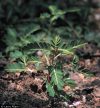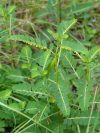




Chamberbitter
DESCRIPTION: Chamberbitter is a small weed that is native to tropical and subtropical regions that is fast-spreading and resiliant making it challenging to control. Indigenous communities in South America have long used this weed for treating liver problems and urinary tract infections. It is still used in traditional medicine in many parts of the world.
SCIENTIFIC NAME: Phyllanthus urinaria
OTHER NAMES: Gripeweed, Little Mimosa
LEAF TYPE: Broadleaf
FLOWERS: Flowers will be small (less than half a centimeter in size) and yellow-green in color. Flowers contain tiny, flattened, round seeds that are enclosed in a capsule. When these capsules mature, they burst and forcibly eject seeds, dispersing them in the immediate vacinity. This process, known as explosive dehiscence, can scatter seeds several feet away from the parent plant allowing it to spread rapidly.
LEAVES: Leaves are small and oval shaped with smooth edges. They are green and grow in an alternating pattern along the stem of the plant.
LIFE CYCLE: Annual
HOW TO IDENTIFY: The easiest way to identify chamberbitter is by its striking resemblance to a mimosa tree. It will be less than 2 feet tall and where there's one, there are usually many more. Chamberbitter will also have a long taproot if allowed to mature long enough.
MECHANICAL CONTROL RECOMMENDATIONS:
CHEMISTRY RECOMMENDATIONS:
Recommended Prevention
Recommended Control

